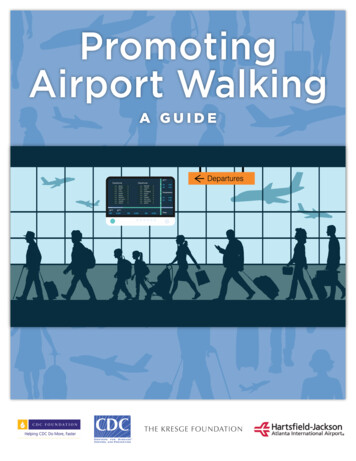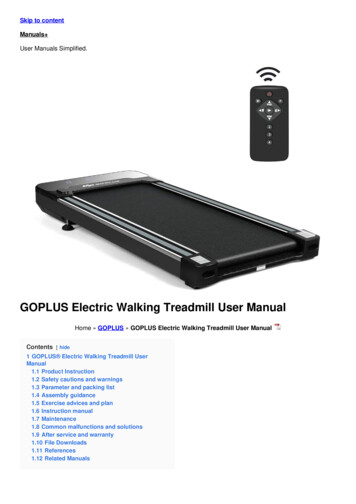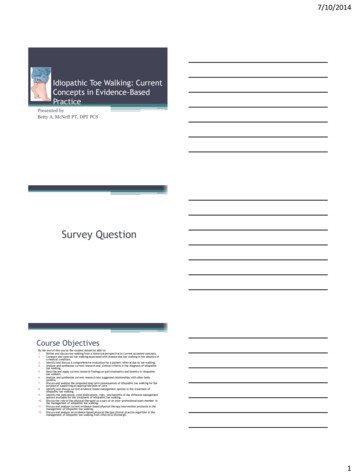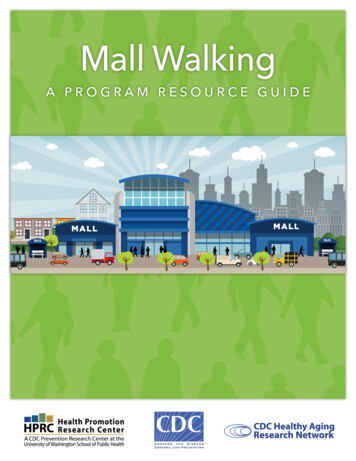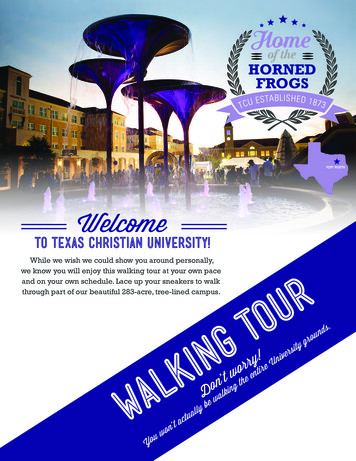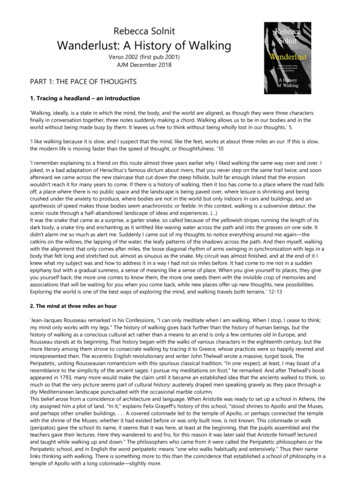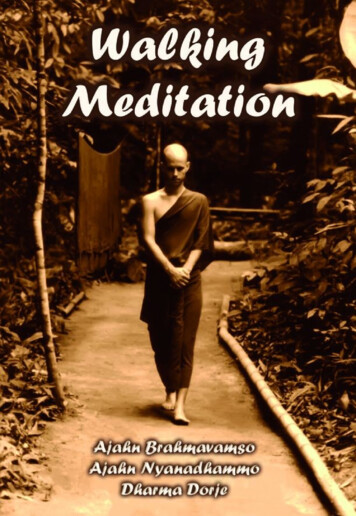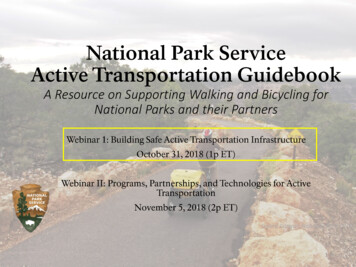
Transcription
A Resource on Supporting Walking and Bicycling forNational Parks and their PartnersGrand Canyon National Park (NPS)1
Webinar Series SpeakersKrista SherwoodNPS Conservation &Outdoor RecreationProgramsTim YoungWyoming PathwaysRichard MenickeGlacier National ParkJessica BaasU.S. Department ofTransportation Volpe CenterLauren McKean, NPS Cape CodNational SeashoreMorgan LommelePeople for Bikes2
Speaker IntroductionKrista SherwoodNational Park ServiceConservation & Outdoor Recreation Programs3
Webinar Overview Guidebook Overview Case Studies:1. Success of the Grand TetonPathways System2. Implementing the Outer CapeBicycle and Pedestrian Master Plan Q&A Learn MoreCrater Lake National Park (NPS)4
Webinar logistics Participants are in listen only mode. Enter question through chat pod at any time. Therewill also be an opportunity to ask questions overthe phone. The webinar is being recorded.5
Active Transportation GuidebookThis Guidebook is intended to assistand inspire parks and their partnersto identify and pursue opportunitiesthat enhance active transportationto and within national parks.Topics Include: Policies Infrastructure Safety Programs Events Sharing & Rental Systems Employee Programs Trends & Technology6
Active Transportation GuidebookThis Guidebook was developed collaboratively with support from thefollowing partners: NPS Transportation Branch NPS Rivers, Trails, & Conservation Assistance Program NPS Denver Service Center Volpe National Transportation Systems Center Federal Highway Administration Office of Federal Lands Highway Office of Planning, Environment, and Realty Adventure Cycling AssociationCenters for Disease Control and PreventionOpen Streets ProjectPeopleForBikesAnd Others7
Active Transportation Helps Parks andCommunities Overcome Challenges through: Management of VehicleCongestion Promoting ResourcePreservation AccommodatingIncreased Visitation byProviding Alternativesto DrivingGlacier National Park (Volpe Center)8
Benefits of Active Transportation inParks Resource Protection Visitor Experience Equitable Access Public Health Congestion Relief Economic and SocialBenefitsDenali National Park (NPS)9
Role of Partnerships Promoting awareness andexcitement Collaborating on planning products,programs, and projects Pursuing and securing funding Improving bicycling and pedestrianinfrastructure in gatewaycommunities Receiving diverse and useful input Encouraging continuousengagement and participation bythe communityTop: Acadia National Park (Volpe Center)Bottom: Shenandoah National Park (NPS)10
Speaker IntroductionJessica BaasU.S. Department of Transportation Volpe Center11
Guidebook Chapters1. Legal and PolicyFramework2. Planning and Elementsof Project Development3. Infrastructure andMultimodal Connectivity4. Bicyclist and PedestrianSafety6. Visitor Activities and Programs7. Open Streets Opportunities8. Bicycle Sharing and RentalSystems9. Employee Programs and ParkOperational Uses10. Innovative Technologies andEmerging Trends5. Partnerships andFunding12
Guidebook Chapters1. Legal and PolicyFramework2. Planning and Elementsof Project Development3. Infrastructure andMultimodal Connectivity4. Bicyclist and PedestrianSafety6. Visitor Activities and Programs7. Open Streets Opportunities8. Bicycle Sharing and RentalSystems9. Employee Programs and ParkOperational Uses10. Innovative Technologies andEmerging Trends5. Partnerships andFunding13
Chapter 1: Legal and Policy Framework Policies: NPS Management Policies NPS Bike Rule Superintendent’s Compendium (parkspecific) Transportation funding: Federal Lands Transportation Program(FLTP) Federal Lands Access Program (FLAP)for partnerships with states, counties,and local entities Federal policies apply to any projectreceiving federal funding.Shenandoah National Park (NPS) State and local policies on walkingand bicycling may also affect activetransportation to and within parks.14
Chapter 2: Planning and Elements of Project Development Considering pedestrian and bicyclingissues alongside transportationenhancement projects. Major plans that influence parks: NPS National Long RangeTransportation Plan NPS region-specific plans Foundation Documents andGeneral Management Plans (parkspecific) Partner planning documents (stateand region) Feasibility studies and inventories ofexisting conditions and programscan be used to identify projects.National Mall (M. Gersema)15
Chapter 3: Infrastructure and Multimodal Connectivity Pedestrian infrastructure(e.g., sidewalks, trails,pedestrian refuge islands) Bicycle infrastructure (e.g.,signage for shared lanes,bike lanes, bike parking) Multiuse trails Intersections andcrossings Signage Connections to othermodesPhotos (clockwise from top left): Connect Historic Boston (VolpeCenter); San Antonio Missions National Historical Park (NPS);Bryce Canyon National Park (Volpe Center); Glacier National Park16(S. Snow)
Chapter 4: Bicyclist and Pedestrian Safety Parks can improvesafety for activetransportation usersthrough the 4 E’s: EngineeringEducationEnforcementEmergency responseGrand Teton National Park (NPS)Natchez Trace Parkway (NPS)17
Case StudiesGrand Canyon National Park (NPS)18
Speaker IntroductionCase Study: Success of the Grand Teton Pathways SystemTim Young, Wyoming Pathways19
Grand Teton National ParkSuccess of the Grand Teton Pathways SystemEnhanced Visitor Experience – Improved Transportation OptionsNPS Active Transportation Guidebook Webinar – October 31, 2018Tim Young, Wyoming Pathways
Jackson Hole - Gateway Community PartnerToday Jackson Hole Transportation 25,000 residents 4.5 million Visitors/year Gold level Bicycle Friendly Community 70 Miles of Pathways - more coming! Wyoming’s largest Transit System Jackson Complete Streets Policy Economic, Livability Benefits Demonstrated“A national model for visitor access withroadways safe for people and wildlife, aquality pathway system for bicycling andwalking, pedestrian friendly activity areas,and an inviting transit system.”
Active Transportation VisionGrand Teton National Park& Jackson Hole Community Over 100 miles of combined Pathways SystemsRobust Regional Transit SystemPartnership Local/State/FederalSafe Functional RoadwaysWalkable Activity/Town CentersHealthy Park ResourcesHealthy Visitors, ExperiencesHealthy Gateway Community
Grand Teton National Park -Turning Tragedy into Trails50 Year Pathway Timeline Community support for safe bicycling dates back to late 1960’sGRTE 1976 Master Plan “Provide new modesand paths of visitor access ”1978 GRTE Bicycle Plan – good plan butnever implemented.1991 Jackson Community Pathways tart1996 Teton County offers NPS partner help1999 Gabriella Axelrad, cyclist fatality2000 NPS Park Transportation Study starts2001 Jeff Pool, second GRTE bicyclist fatality2002 Park EIS begins2004 Senator Thomas 1st Appropriation 4m2007 ROD 42-mile park pathway system2008 First Pathway Construction startsPark Pathways – Instant Visitor Success!The path to pathways included:
Bike Fatalities, Annual Memorial Rides raised awareness and public support –U.S. Senator Craig Thomas & Senator John Barrasso Champion PathwaysSecured 14 million federal appropriations for Grand Teton Pathways
U.S. Senator John Barrasso Supports Park Pathways
Moose to Jenny Lake Construction Starts in 2008
Teton County ConstructedNorth 89 Pathway along National Elk Refuge in 2010-2012Funding Sources: Federal Stimulus Grants Local Voter-ApprovedSales Tax Ballot Teton County ledDesign, Construction 6 million/6 miles withbridge and underpass
Teton County to Grand Teton Connection 2011-2012
August 2012 – U.S. Secretary Ray LaHood presents anAmerica’s Great Outdoors Award to Grand Teton National Parkfor the North 89 Pathway from Town of Jackson to Moose“We are doing this for these guys and future generations”Secretary LaHood, with three of his grandkids
In 2016 GRTE Superintendent David Vela Opens Antelope FlatsPathway, adds connection to the quieter east side of park
Progress to date: 21 Miles Federal Lands Pathways 2008 First 8-mile GRTE Pathway 2011 Teton County adds 6-mileElk Refuge N. 89 Pathway 2012 National Park adds 6-miles 2016 GRTE adds 1.2-miles toAntelope Flats Today - Jackson to Jenny Lake!
Benefits?Enhanced Visitor ExperienceVibrant Gateway Community Improve Safety for everyone Improve Health - Visitors &Residents Enhance Access and Accessibility Protect Air Quality Promote Energy Conservation Quality Interpretive Opportunities Low impact and easy to manage
Economic Benefits of People-Powered ModesUniversity of WyomingEconomic Impact Study:Jackson Hole Trails ProjectStudy Results were impressiveTotal Expenditures and Economic Impacts Figure 4.18SourceEstimated Local Trail User ExpendituresEstimated Non-Local Trail User ExpendituresTOTALCounty Specific & General Purpose Tax, 2%State of Wyoming Sales Tax, 4%Employee Wages & SalariesDollar Amount 784,255 17,712,240 18,496,495 369,930 739,860 3,598,045
Tourism, Quality of Life Benefits of Human-Powered ModesWell Maintained Trail Systems are Important to myDecisions for Travel Destinations [Figure 4.8]1.3114.533.749.5Strongly AgreeAgreeNeutralDisagreeStrongly DisagreeWell maintained trail systems are important to my quality oflife at my residence [Figure 4.9]1.39.92Strongly AgreeAgreeNeutral23.463.4DisagreeStrongly DisagreeUniversity of WyomingEconomic Impact Study:Jackson Hole Trails Project
What about Pathways and Wildlife?Grand Teton National Park Pathway& Wildlife Studies Summary: Negligible impacts from pathwaysand use; no serious problems. Unlike motor vehicles, no wildlifehas been killed by bicycles.“ Overall, results suggest thepathway did not affect how elkutilize the area or reduceopportunity of visitors to view elk”“ Overall results did notdemonstrate alterations in ungulatedistribution”
Pathway User Study: Analysis of Nonmotorized Use in Grand Teton Park:“Conclusion The one major suggestion given by almost everyone riding the pathway –Extend the shared use pathway. People love the pathway and want it to go farther.People want to get out of the car. People want to feel Grand Teton National Park. On abicycle it blows in your face, it can be smelled, it is seen unobstructed, and the slower paceallows time for it all to soak in.”
From 8 to 80, Grand Teton Pathways have proven a remarkablesuccess for visitors, park employees, local community residents
Recommendations and Lessons to Share: Beyond the GuidebookBetter Training, Planning, Funding, Design and ConstructionNational Park Service1. Provide regular training for NPS staffon best practices for planning andproject leadership at individual Parksand NPS Regions.2. Consider a NPS Active Transportationset aside in the Federal Lands HighwayProgram, so that there is more hopefor bike/ped facilities to competewith Highways.3. Leadership should set andcommunicate a higher priority forActive Transportation, as NPSManagement Policy 9.2 clearly states.FHWA Federal Lands Highway Divisions1. Provide technical training for FHWA projectdesign staff on best practices in design.2. Require design staff to renew training atregular intervals, 3-5 years.3. Evaluate the high cost of project design anddelivery, and consider methods to bringthese down while also improving design quality.
Thank You!Good luck with your pathway!tim@wyopath.org and 307-413-8464
Speaker IntroductionCase Study: Implementing the Outer Cape Bicycle and PedestrianMaster PlanLauren McKeanNPS Cape Cod National Seashore40
Cape Cod National SeashoreNational Park Service
Cape Cod National SeashoreNational Park Service
Cape Cod National SeashoreNational Park Service
Cape Cod National SeashoreNational Park Service
Cape Cod National SeashoreNational Park Service
Cape Cod National SeashoreBike Plan Master PlanPrimary Route· Use state DCR-owned former railroad bed frompresent terminus to Rt. 6 Wellfleet near Main St.intersection· Develop fully separated, multi-use path alongstate DOT Route 6 corridor from Wellfleet Centerto Herring Cove BeachNational Park Service
Cape Cod National SeashoreBeginning implementationwith interim primary routeHead of theMeadowBicycle PathCC NationalSeashorecontractedHead of theMeadowBicycle Pathrehab &hardening OldKing’sHighway toconnect toTruroHighlandsareaattractions fall2018National Park Service
Cape Cod National SeashoreSecondary Networkon park land· Signage, “sharrows”, and future shoulders along MarconiBeach Road from Route 6 to the beach (1.7 miles);· “Share the Road” signage along Marconi Site Road(1 mile);· Signage “sharrows”, and future shoulders along Head ofthe Meadow Road (0.9 mile);· (interim primary route) Rehab and minor widening of the Head of theMeadow Bicycle Trail (1.9 miles); hardening of the Old King's Highwaysand road connector between Head of the Meadow Road and Coast GuardRoad (0.8 mile); stabilizing unpaved High Head Road (0.6 mile), as needed· Rehabilitation of the existing Province Lands Bike Trailbike path from the NPS boundary at Race Point Road toBeech Forest (0.3 mile);· Reuse and rehab of former 2-lane Route 6 roadbed atpark boundary for a bicycle path to Herring Cove Beach(0.4 mile)National Park Service
Cape Cod National SeashoreNational Park Service
Q&AGolden Gate National Recreation Area (NPS)50
Learn MoreYellowstone National Park (NPS)51
Resources and Contacts Download the ion/bikeped.htm Webinar Speakers: Krista Sherwood: Krista Sherwood@nps.govJessica Baas: Jessica.Baas@dot.govTim Young: tim@wyopath.orgLauren McKean: lauren mckean@nps.gov NPS Regional Transportation ntact us.html52
Grand Canyon National Park (NPS) Speaker Introduction 19 Tim Young, Wyoming Pathways Case Study: Success of the Grand Teton Pathways System. NPS Active Transportation Guidebook Webinar - October 31, 2018 Tim Young, Wyoming Pathways Grand Teton National Park Success of the Grand Teton Pathways System Enhanced Visitor Experience -Improved Transportation Options . Jackson Hole - Gateway .

